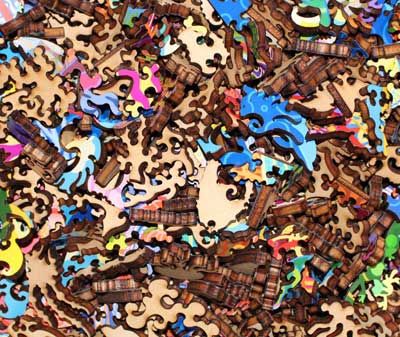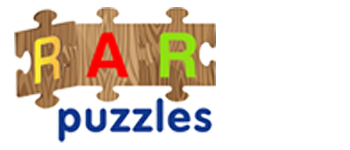In the last few years the popularity of Wood Puzzles has grown immensely. There are many reasons for this, but the Covid Pandemic was a huge catalyst in either getting people familiar with puzzling for the first time or, more likely, “reacquainted” with puzzles from years ago. With many people staying home and having watched everything that streaming TV had to offer, they were ready to go back to a non-screen based activity and puzzles were one of the most popular to fill that need.
Before we go further, a very short puzzle history is needed. During the Great Depression, there was a huge puzzle craze. With people staying home to save money they were looking for inexpensive entertainment. Enter puzzles. Almost overnight, puzzle companies were springing up in every corner. Cardboard puzzles were readily available and puzzling became a national obsession. At the same time, unemployed artists and other “creators”, although they weren’t called that at the time, began to cut wood puzzles in garages and workshops, especially in the northeast US.
 Out of this puzzle revolution sprang some well known brands, including one of the most well known and sought after puzzle brands, Par Puzzles. But there were also hundreds of other companies looking to fill this puzzling need. Puzzle sharing libraries (essentially puzzle rental businesses) also made puzzles available at an affordable rental price. Many consider this era during the Depression the heyday of puzzling.
Out of this puzzle revolution sprang some well known brands, including one of the most well known and sought after puzzle brands, Par Puzzles. But there were also hundreds of other companies looking to fill this puzzling need. Puzzle sharing libraries (essentially puzzle rental businesses) also made puzzles available at an affordable rental price. Many consider this era during the Depression the heyday of puzzling.
Fast forward about 90 years and a pandemic forces people to stay home. While puzzles have never gone out of style, millions of people who probably hadn’t puzzled since they were in preschool decided to start puzzling again and a puzzle craze sweeps the country again. We’ll call this Puzzling 2.0. Only this time, things have changed a lot from the production, design and ordering process (i.e. instant online ordering) perspective when it comes to wood puzzles. Yes, there are still a fair number of hand cut puzzle companies churning out amazing designs and original styles. But technology has also come a long way. With the advent of lasers that can cut a puzzle piece into just about any pattern you can think of, a whole new world of puzzling experience has opened up in the 21st century. With relatively low startup costs, many new puzzle companies that focused on laser cut puzzles launched, in the early 2020s.
So what are the main differences between laser cut and hand cut puzzles? One thing to keep in mind is that they are a bit hard to compare head to head. It’s sort of like making the same comparison between cardboard and wood puzzles. Yes, they are both jigsaw puzzles, both made out of wood and may have some similar features, but there are also some fairly large differences as well. So while they are more similar to each other than the cardboard to wood categories, there are some significant differences that are important to note.
Silhouette Pieces
Laser cut puzzles can have very intricate silhouette pieces that would be very difficult and in some cases impossible for somebody hand cutting a puzzle. This allows for innovative and complicated designs such as thinly cut swirls or lots of little burned in details that are not possibly cutting by hand. They also tend to have a higher ratio of silhouette pieces. However, because they are usually designed to be cut by a template, it takes more effort to have personal pieces added to the puzzle, so, in our experience, it is a lot less common to find customized personal pieces in laser cut. Not to say it’s not done, but personalized pieces are generally more common with hand cut puzzles.
Quality
This is very subjective. In general, we have come across many very high quality laser cut puzzles over the years. Despite many companies, although not all, use the same thickness ¼” wood as hand cut, It does seem like laser puzzle pieces are lighter. We haven’t done an in-depth analysis of wood used for laser puzzles, so it may be lighter wood is used in the process for various reasons. But this seems to vary by manufacturer, so a general conclusion can’t be made on the weight.
The biggest difference we have found is due to the wood literally being burned through by the laser to cut the puzzle, generally the pieces fit together a little looser than hand cut. This is probably from the width of the cut the laser needs to make to get through the wood. Whereas puzzles cut with a scroll saw can use very fine blades which allows for that unique ability to left a completed puzzle with 2 fingers and it stays together! Usually not a big deal, but there is a difference in the way the pieces feel when they go together. The hand cut often feel more solid in this area.
Smell
So yeah, this is a weird category but needs to be mentioned. Laser cut puzzles do have a wood burned smell to them, especially when first opening the box. It kind of smells like a campfire. Some people love it, others find it overwhelming, so an interesting sensory difference other than the feel of the puzzles.
Cost:
Because laser puzzles can be mass produced in a factory like fashion via templates and the most time consuming part for non-laser puzzles, the actual cutting, can be done by a machine, they cost significantly less than hand cut. This has also played a role in the popularity of wood puzzles increasing recently, especially laser. With this reduced cost, many people who used to only buy cardboard have switched to wood puzzles.
There are a number of other differences, but these are the 4 main ones we have found. As mentioned earlier, it’s not really an “either or”, but should be looked at as two very different kinds of puzzles for different puzzling experiences. We have come across puzzle fans who prefer one or the other and many who enjoy both. Each giving a unique puzzling experience.
